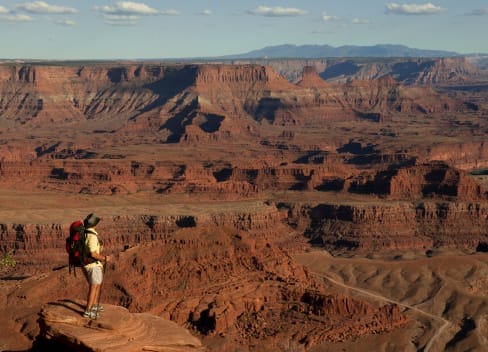This past spring break, I attended a week-long Wharton Leadership Ventures expedition, where I had the chance to build leadership skills through hiking, mountain biking, camping and canyoneering in the remote Red Rocks Desert of Utah. We completed a social-impact project for the Native American Financial Officers Association, where we developed recommendations for how the association could effectively build programs targeted at Native American high school and college students, encouraging them to major in finance or business in college in order to help their communities develop after graduation.
During the expedition I experienced camping in desolate areas for nearly a week, far from electricity, fresh water or other people. At night, we sat around a fire, reflected on how the leader of the day led the group and worked on the social-impact project. I hiked down deep canyons, explored ancient Anasazi ruins and trekked through stunning desert vistas. I biked in Canyonlands National Park down challenging terrain and learned to trek across steep paths.

Chris Maxwell, associate director, Wharton Undergraduate Leadership Program
I was student venture coordinator for the expedition and was able to practice leadership skills in organizing the participants prior to the expedition, facilitating leadership activities during the venture and guiding the social-impact project that we completed. I was responsible, along with Dr. Chris Maxwell, Wharton Leadership Ventures faculty advisor, and Christian Santelices, a professional mountain guide from Aerial Boundaries, for ensuring that the trip was executed smoothly.
I learned a great deal by observing the way Christian led and from lessons Dr. Maxwell shared from his ongoing research project on how outdoor guides lead and motivate groups. Christian said his role is to “teach, coach and guide,” which immediately resonated with me because I saw how this could be applied in any team setting where the leader needs to be able to seamlessly switch between maintaining control of a group in difficult situations, equipping team members with the knowledge they need to help achieve objectives and serving as a mentor to team members. I observed the way Christian would walk at “guide’s pace” whether we were walking on flat terrain or scaling a challenging vertical ascent. Guide’s pace is the pace at which the guide is able to keep moving forward without stopping or getting too far away from the group. Walking at guide’s pace encouraged team members to keep going while making the goal of scaling difficult terrain achievable.
 At the end of the expedition, Christian remarked that he viewed being courageous as achieving more than was thought possible, never giving up even through challenging times and breaking through obstacles to succeed.
At the end of the expedition, Christian remarked that he viewed being courageous as achieving more than was thought possible, never giving up even through challenging times and breaking through obstacles to succeed.
As I reflect on what I accomplished during the expedition and the leadership lessons I learned, I can see how the experience has made me a better leader at Wharton and beyond. I learned the proper role for a leader, how a leader can set the pace of a group and the true meaning of what it means to be courageous.
Editor’s note: This post first appeared on the Undergraduate Program’s Student Voices blog, along with a video, on July 16, 2012.

























